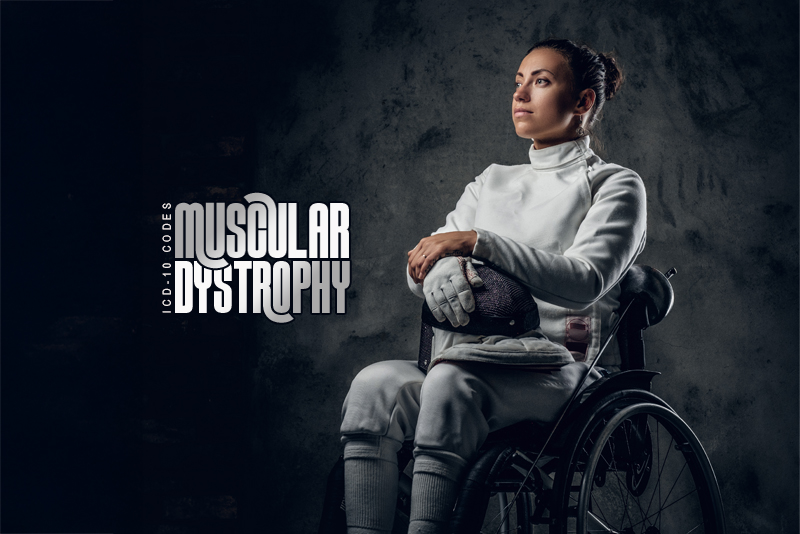Muscular Dystrophy (MD) is a group of over 30 genetic disorders that cause progressive muscle degeneration and weakness. As healthcare practitioners, staying updated on the latest diagnostic procedures and associated ICD-10 codes or partnering with a medical coding company is important for patient care, accurate documentation and billing. In this blog, you will learn about the common types of muscular dystrophy, diagnoses and the relevant ICD-10 codes.
Common Types of Muscular Dystrophy
Muscular dystrophy is not a single disease but a group of conditions that vary in onset, intensity and muscles affected. As the condition worsens, it becomes difficult to move and can affect breathing, heart function which can be life-threatening. Below are the most common types of MD:
- Duchenne Muscular Dystrophy (DMD): This is the most common and severe form of MD, generally affecting boys from a younger age and patients often will require a wheelchair when they approach teenage. The disease is caused by mutations in the dystrophin gene.
- Myotonic Dystrophy (DM): This is the most common adult form of MD and affects men and women equally. It is characterized by myotonia (delayed muscle relaxation), muscle wasting, and weakness, often beginning in the face and neck muscles.
- Becker Muscular Dystrophy (BMD): BMD is similar to Duchenne but less severe, as it generally shows up in childhood or adolescence. BMD is characterized by a partially functional dystrophin protein, leading to a slower disease progression.
- Limb-Girdle Muscular Dystrophy (LGMD): This type targets the shoulder and hip muscles. LGMD can show up at any age and the severity varies upon the specific gene mutation involved.
- Facioscapulohumeral Muscular Dystrophy (FSHD): FSHD, as the name suggests, affects the muscles of the face, shoulders, and upper arms. Symptoms typically appear during teenage, but can also develop later in life. It often leads to progressive weakness in these areas.
- Congenital Muscular Dystrophy (CMD): More than just a type, CMD refers to a group of muscular dystrophies present at birth or even in infancy. The characteristics of this type involve muscle weakness, joint contractures, and respiratory/cardiac complications.
- Emery-Dreifuss Muscular Dystrophy (EDMD): EDMD primarily affects muscles used for movement and the heart. Symptoms include joint contractures and cardiac abnormalities, such as arrhythmias.
Diagnosis
The diagnosis of MD is multi-faceted but begins with a combination of clinical evaluation and physical examination (for e.g., genetic testing and muscle biopsies).
- Clinical Evaluation: This involves a comprehensive analysis of the patient’s medical history, existing symptoms and a physical exam that will assess muscle strength, tone, reflexes, and the presence of contractures or scoliosis.
- Gene Testing: Genetic tests can help pick out specific mutations in the gene that are responsible for producing dystrophin and other essential proteins. This test can help confirm a diagnosis regarding the forms of MD.
- Electromyography (EMG) and Nerve Conduction Studies (NCS): These tests are performed to get an idea of the current electrical activity of muscles and nerves to distinguish MD from other neuromuscular disorders.
- Creatine Kinase (CK) Levels: Elevated levels of CK—an enzyme released from damaged muscles, could be an indication of muscle disease, although abnormal CK is not specific to MD.
- Cardio-Respiratory Tests: Examination of heart is done to identify any irregularities, especially in patients diagnosed with myotonic muscular dystrophy. Lung examination is also performed to validate proper lung function.
Automate & Streamline Your Practice’s Patient Management
Choose our expert medical billing services
Updated ICD-10 Codes for Muscular Dystrophy
Proper coding of muscular dystrophy is essential for reimbursement and patient management. The ICD-10 coding system came into effect in 2015, replacing ICD-9 with more specific and detailed codes to help classify MD clearly.
Primary Muscular Dystrophy Codes
- G71.0 – Muscular Dystrophy: This is the broadly used code for all types of muscular dystrophy, but it is generally advised to use more specific codes where available.
- G71.01 – Duchenne Muscular Dystrophy: This code is specifically used for Duchenne Muscular Dystrophy (DMD), the most severe form of MD.
- G71.02 – Becker Muscular Dystrophy: This code is used for Becker Muscular Dystrophy (BMD), a less severe variant of DMD.
- G71.03 – Congenital Muscular Dystrophy: This code is used for the form of MD which is typically diagnosed at or near birth with various genetic mutations.
- G71.04 – Facioscapulohumeral Muscular Dystrophy: This code should be used for patients with FSHD, characterized by progressive weakness in the face, shoulders, and arms.
- G71.09 – Other Muscular Dystrophies: This code is for MD that are not categorized under other codes, such as limb-girdle muscular dystrophy (LGMD) and myotonic dystrophy (DM).
- G71.1 – Myotonic disorders: This is a broad classification for myotonic disorders. Under this category, these conditions are caused by genetic mutations causing abnormal muscle contractions—mostly myotonia, which is the inability of muscles to relax after contraction.
The G71.1 also includes a range of other myotonic disorders including, but not limited to:
- G71.10 Unspecified myotonic disorder
- G71.11 Myotonic muscular dystrophy
- G71.12 Myotonia congenita
- G71.13 Myotonic chondrodystrophy
- G71.14 Drug induced myotonia
- G71.19 Other specified myotonic disorders
Associated Complications and Comorbidities
- I49.8 – Other Specified Cardiac Arrhythmias: This code refers to Duchenne, Becker, and Emery-Dreifuss MD patients with cardiac complications, including arrhythmias.
- I42.8 – Other Cardiomyopathies: Cardiomyopathy is another common complication associated with MD patients, specifically in DMD and BMD.
- J96.1 – Chronic Respiratory Failure: Respiratory complications are often seen in advanced stages of MD, especially in DMD and CMD, which requires extra care to the patient’s lung function.
Muscular Dystrophy can be any of 30 genetic conditions that causes progressive muscle weakness. The onset and severity is different for different people as it progresses at a varied pace, for every affected individual. Consulting a company that offers expert medical billing services, can help gain an understanding of the forms and complexities of MD, proper diagnoses and usage of ICD-10 codes, which is crucial for healthcare providers in administering appropriate medical care.
The new ICD-10 codes serve a significant role in proper reimbursement for the practitioners and it is important to frequently consult the ICD-10 guidelines to stay updated with the latest codes for a better overall billing and patient care experience.




